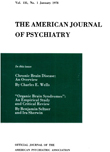PSYCHODYNAMIC CONSIDERATIONS IN GILLES DE LA TOURETTE'S DISEASE (MALADIE DES TICS)
Abstract
1. Gilles de la Tourette's disease is a relatively uncommon disorder, there being only 4 cases on record among approximately 9,000 inpatient and 50,000 outpatient admissions to the Henry Phipps Psychiatric Clinic.
2. In 4 of 5 cases the patient was either foreign-born or first generation American-born. One of the parents was rigid and domineering, it being the father in four of the 5 cases.
3. The patients were all obedient, well-behaved, and somewhat perfectionistic as children but showed a marked change in behavior at the time of onset of the illness.
4. In all instances a history of a precipitating event was given; however, there was evidence that, in some patients at least, the symptoms were present prior to this event.
5. Although the meaning of the motor movements was not entirely understood, the symptoms of echolalia and coprolalia appeared to be related to certain attitudes the patient had toward one or both parents (or husband) and also constituted an attempt to suppress their expression.
6. Inasmuch as coprolalia interferes with the patient's acceptance by his environment, even though it might temporarily decrease his anxiety over his hostile feelings, a basis for a psychotic withdrawal is established.
7. There is considerable resemblance of the clinical manifestations of Gilles de la Tourette's disease to the symptomatology of schizophrenia, particularly as regards stereotyped mannerisms and speech.
8. In the cases reported here neither clinical nor laboratory examinations were indicative of organic disease. Although there was emotional maladjustment among some family members, a hereditary factor in the etiology of the illness appeared unlikely.
9. Regardless of the therapist's concept of etiology, psychiatric treatment should be prompt, aided by the useful employment of the knowledge gained from the understanding of the patient's symptoms in terms of his attitudes and personality functioning.
10. The therapeutic efforts might possibly be hampered by the presence of central nervous system pathology, even though this is hardly supported by clinical evidence; postmortem examination should prove helpful to throw more light on this matter.
Access content
To read the fulltext, please use one of the options below to sign in or purchase access.- Personal login
- Institutional Login
- Sign in via OpenAthens
- Register for access
-
Please login/register if you wish to pair your device and check access availability.
Not a subscriber?
PsychiatryOnline subscription options offer access to the DSM-5 library, books, journals, CME, and patient resources. This all-in-one virtual library provides psychiatrists and mental health professionals with key resources for diagnosis, treatment, research, and professional development.
Need more help? PsychiatryOnline Customer Service may be reached by emailing [email protected] or by calling 800-368-5777 (in the U.S.) or 703-907-7322 (outside the U.S.).



